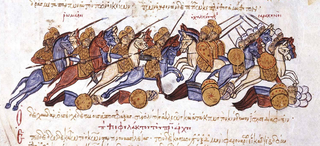 W
WSaint Basil the Younger was a Byzantine Greek holy man and visionary. He is the subject of a Greek hagiographical biography, the Vita sancti Basilii iunioris, written by his pupil Gregory. Although the Vita portrays its subject as historical, there is yet no consensus whether Basil or even Gregory were real persons or fabrications.
 W
WThe patrikios Niketas Chalkoutzes was a Byzantine general, the first attested member of the Chalkoutzes family, and most notable for his recovery of Cyprus from the Arabs in 965.
 W
WHero of Byzantium is a name used to refer to the anonymous Byzantine author of two treatises, commonly known as Parangelmata Poliorcetica and Geodesia, composed in the mid-10th century and found in an 11th-century manuscript in the Vatican Library. The first is a poliorketikon, an illustrated manual of siegecraft; the second is a work in practical geometry and ballistics, which makes use of locations around Constantinople to illustrate its points. The manuscript consists of 58 folios and 38 colored illustrations.
 W
WJohn Kaminiates was a Greek resident of Thessalonica when the city, then one of the largest in the Byzantine Empire, was besieged and sacked by a Saracen force led by Leo of Tripoli in 904. His account of the city's plunder, On the capture of Thessalonica, survives in four manuscripts; though of these, none were written before the fourteenth century, causing some concern over the text's authenticity.
 W
WZoe Karbonopsina, also Karvounopsina or Carbonopsina, i.e., "with the Coal-Black Eyes", was an empress consort and regent of the Byzantine empire. She was the fourth spouse of the Byzantine Emperor Leo VI the Wise and the mother of Constantine VII, serving as his regent from 914 until 919.
 W
WManuel Erotikos Komnenos was a Byzantine military leader under Basil II, and the first fully documented ancestor of the Komnenos dynasty. His origin and parentage is obscure. He is only mentioned in the sources as leading the defence of Nicaea in 978 against the rebel Bardas Skleros, and as an imperial envoy to him 11 years later. He had three children, late in life. The eldest, Isaac, became emperor in 1057–1059, and the youngest, John, was the progenitor of the Komnenian dynasty as the father of Alexios I Komnenos.
 W
WIrene Lekapene was the Empress consort of Peter I of Bulgaria. She was а daughter of Christopher Lekapenos, son and co-emperor of Romanos I Lekapenos, and his wife Augusta Sophia.
 W
WLeo of Tripoli, known in Arabic as Rashīq al-Wardāmī, and Ghulām Zurāfa, was a Greek renegade and fleet commander for the Abbasid Caliphate in the early tenth century. He is most notable for his sack of Thessalonica, the Byzantine Empire's second city, in 904.
 W
WLuke of Steiris, Luke Thaumaturgus, Luke the Younger, Luke of Hellas, or Luke the Wonder-worker was a Byzantine saint of the tenth century AD who lived in the themes (provinces) of Hellas and Peloponnese in Greece, and who founded the Monastery of Hosios Loukas on the slopes of Mount Helicon, between Delphi and Levadia, near the coast of the Gulf of Corinth in Boeotia, Greece. He was one of the earliest saints to be seen levitating in prayer.
 W
WSaint Peter the Wonderworker or the Thaumaturge, also known as Saint Peter of Argos is a Christian saint, regarded as the patron saint of Argos.
 W
WLeo Phokas or Phocas was a prominent Byzantine general who scored a number of successes in the eastern frontier in the mid-10th century alongside his older brother, the Emperor Nikephoros II Phokas. He served as chief minister during his brother's reign, but was dismissed and imprisoned by his successor, John Tzimiskes.
 W
WBardas Skleros or Sclerus was a Byzantine general who led a wide-scale Asian rebellion against Emperor Basil II during the years 976 to 979.
 W
WSymeon the Metaphrast was the author of the 10-volume medieval Greek menologion, or collection of saints' lives. He lived in the second half of the 10th century. About his life we know only very few details.
 W
WAshot Taronites was a Byzantine nobleman. Captured by the Bulgarians in 995, he was released in 996 and married to Miroslava, daughter of Tsar Samuel of Bulgaria. Appointed governor of Dyrrhachium by Samuel, he and his wife fled to Constantinople and arranged for Dyrrhachium to be handed over to Byzantine rule.
 W
WTheodora III Porphyrogenita was Byzantine Empress from 19 April 1042 to her death on 31 August 1056. She was sole ruler from 11 January 1055. She was born into the Macedonian dynasty that ruled the Byzantine Empire for almost two hundred years.
 W
WVastas is a village in the municipality of Megalopoli, Arcadia, Greece. It is situated on a mountainside near the border with Messenia, at about 850 m elevation. It is known for its "miracle church" of Saint Theodora. Vastas is 2 km west of Isaris, 6 km northeast of Kato Melpeia (Messenia), 6 km northwest of Chranoi and 14 km west of Megalopoli.
 W
WTheophanu was empress of the Holy Roman Empire by marriage to Emperor Otto II, and regent of Empire during the minority of their son, Emperor Otto III, from 983 until her death in 991. She was the niece of the Byzantine Emperor John I Tzimiskes.
 W
WZoë Porphyrogenita was Byzantine Empress from 11 November 1028 until her death in 1050.